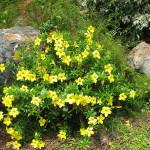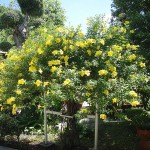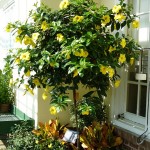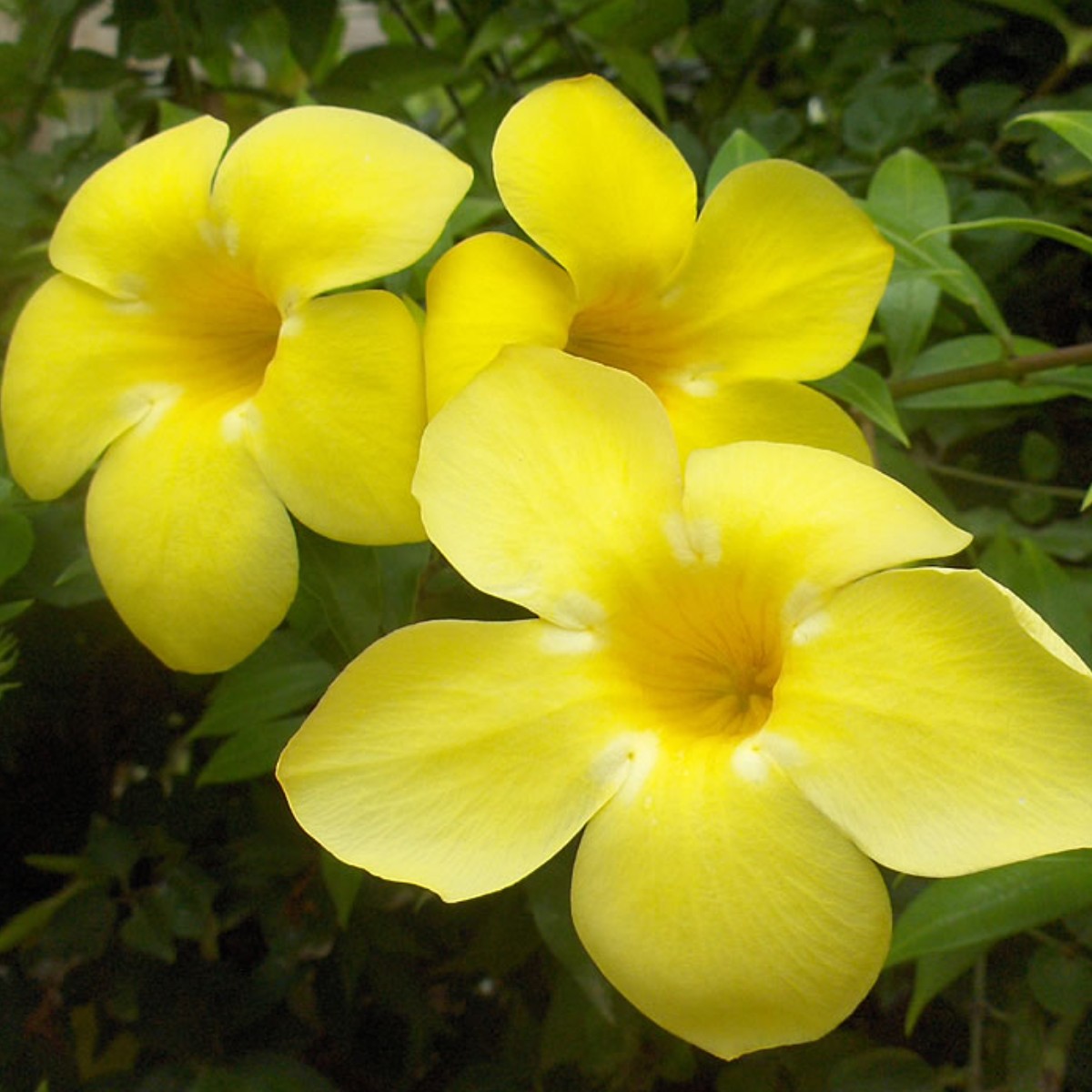Family: Apocynaceae
Synonymous: Allamanda aubletii
Allamanda cathartica var. grandiflora
Allamanda cathartica var. hendersonii
Allamanda cathartica var. nobilis
Allamanda cathartica f. salicifolia
Allamanda cathartica var. schottii
Allamanda cathartica var. williamsii
Allamanda chelsonii
Allamanda grandiflora
Allamanda hendersonii
Allamanda latifolia
Allamanda linnaei
Allamanda salicifolia
Allamanda schottii
Allamanda wardleyana
Allamanda williamsii
Echites salicifolius
Echites verticillatus
Orelia grandiflora
Distribution and habitat: Allamanda cathartica is an evergreen arching, long branched shrub native to Brazil. It is growing near coasts, climbing through trees or shrubs in mangrove swamps and along lowland streams. It prefers moist, well-drained soils in tropical regions, being often found in moist areas as the edges of rivers or swamps.
Allamanda cathartica is widely cultivated as ornamental plant which was escaped and naturalised outside of its natural habitat throughout much of the tropics. It become a weed of roadsides and bushlands, especially along river margins and canals. It is an invasive plant in Australia and some Pacific islands.
The long, trainable stems of Allamanda cathartica plants admit them to classification as vining plants. But the growth is lax and pliable only when it is young, and becomes brittle at maturity.
Description: Allamanda cathartica is a perennial plant which become quite woody over time, but it requires a trellis or a fence for support. It does not twine, nor does it have tendrils or aerial roots. These tropical plants are referred to as vines but they are really shrubs with long stems. It can be pruned into a shrub form. If not pruned it can sprawl to a height of 6m (20 feet).
It is cultivated as an ornamental plant for its large beautiful flowers. Glossy, dark green leaves are 10-15cm (4-6 inch) long and 3-6cm (1-2 inch) wide. They are arranged opposite to whorled of four, with wavy margins and pointed at both ends. The flowers consist of a 2-3cm (0.8-1 inch) long tube flaring into five petals that span 13cm (5 inch). They are golden yellow, occasionally with white markings in the throat. The flowers are produced in clusters (cymes) at the stems tips in summer to fall.
Houseplant care: Allamanda cathartica is a vigorous grower. Provide a trellis to support its vigorous, climbing stems and to show off those glorious golden flowers.
In late winter cut plants back by as much as tow-thirds to control its size, encourage new growth and more flower buds. Cut off spent blooms to encourage more flowers.
Light: Provide bright light to Allamanda cathartica plants with three of four hours a day of full sun. Put the plant in a sunroom or by a sunny window.
Moving this plant outdoors for the summer will enhance the blooming power. Outdoors, place the plant in a semi-sunny spot, protected from the hot afternoon rays. Bring it back inside before the temperature drops to 16C (60F) at night.
Temperature: Allamanda cathartica does not like the cold at all. This tropical plant needs average to warm temperatures 18-27C (65-80F). It will tolerate a minimum of 15C (59F) in winter.
Also this plant needs moderate to high humidity (50% relative humidity or higher). Use a humidity tray or room humidifier to raise the moisture in the air around it.
Watering: During the active growth period water Allamanda cathartica moderately. Water thoroughly, then allow the top 5cm (2 inch) of potting mixture to dry out between waterings. Empty drainage tray to prevent soggy soil.
During the winter rest period water this plant sparingly.
Feeding: Apply standard liquid fertiliser to actively growing plants about once every two weeks.
Potting and repoting: Use a soil based mixture. Move plants to larger pots in spring. When the maximum convenient pot size was reached top dress the plants with fresh potting mixture.
Gardening: Allamanda cathartica is sensitive to frost. It can be kept over winter in greenhouse conditions. Growth will remain active in a tropical greenhouse in winter - continuing flowering all year long - or the plant can be forced into dormancy in an unheated greenhouse. In plant is taking a winter rest, cut back the stems by half, withhold nourishment and allow the soil to dry out between waterings until spring.
The stems must be tied to supports or allowed to ramble over or through other plants. Also, Allamanda cathartica can be pruned and maintained as a shrub. In any case, it may be desirable to prune annually in any case to control for size. Pinch the new stem to encourage basal growth.
Location: Allamanda cathartica plants need bright light and high temperatures during the growing season. The ideal light conditions mimic its native jungle habitat the roots and lower leaves shaded with its new growth reaching out to the sun. A good compromise for pot plants in hot climates is morning sun with afternoon shade.
These plants do not tolerate shade.
Soil: Allamanda cathartica plants like good, rich soils, growing on clay soils, sandy clay soils and feel well in moist substrates. They thrive well in most soils, but becomes chlorotic in very alkaline conditions. So, give them a rich humus soil that is acidic (5.6-6.0 pH) to strongly acidic (5.1-5.5 pH). Plant them with 1.2-1.8m (4-6 feet) between them.
If grown in a container transplant every two years. If the plant is large, do not step up to a bigger pot, but prune the roots instead and replace with a rich potting mix.
These plants do not tolerate salty or alkaline soils.
Irrigation: Allamanda cathartica plants tolerate wet feet, but boggy soil is not compulsory once growth begins. The soil should not dry out. During its flowering period the plant very often requires some extra water to avoid flower loss.
In areas where there is seasonal change, keep fairly dry during winter and prune in spring before growth begins. Continue watering as long as the plant is still blooming, but when flowering is done keep the plant on the dry side until spring.
Fertilisation: Fertilise Allamanda cathartica at regular intervals throughout the growing season. Feed with a liquid food once every two weeks. Stop feeding the plants if they have a winter rest.
Propagation: Plant 8-10cm long tip cuttings of early-spring growth in 8cm pots of a moistened equal-parts mixture of peat moss and coarse sand or perlite. Place each cutting in a plastic bag or propagating case and stand it in bright filtered light at 21C. When rooted, treat the young plants as mature. Move them into the standard mixture after two months.
Problems: Older leaves ofAllamanda cathartica plants may turn yellow and fall off. This is normal process of changing its foliage.
Wilting leaves and dropping shoots are is signs of lack of water.
Treatment: Make sure the plant is receiving enough water, especially during warm, dry times of the year. If the plant is potted and drys out, set the pot in a bucket of water to allow the potting mixture to soak up thoroughly.
Aphids and whiteflies can be a problem, especially indoors. If appear brownish spots or stunted growth, look for aphids on tender growth. White and cottony appearance of leaf undersides may be caused by whiteflies.
Treatment: Successive sprays of insecticidal soaps or white oil will eradicate both aphids and whiteflies infestations.
Watch for mealybugs treat any infestation immediately. Heavy infestations will coat the leaves with sticky honeydew. They appear as white cottony masses found in the leaf axils, underside of leaves and other protected areas.
Treatment: Use appropriate insecticides. Remove with an alcohol saturated cotton swab or wash plants with soapy water and a soft brush or cloth or pick off with tweezers or a toothpick.
Allamanda cathartica are especially susceptible to damage from spider mites. The symptoms are pale looking foliage and cobwebs on the underside of leaves. Leaves begin to drop.
Treatment: Treat the plants with a suitable miticide.
Fungal leaf spots also occur.
Treatment: Apply fungicides and repeat the treatment as directed on fungicide instructions.
Toxicity: The milky sap of Allamanda cathartica plant contains a strong toxin, which may cause severe skin irritation. It is recommended to wear gloves when handling it. All parts of plant are poisonous if ingested.
Note: Allamanda cathartica is considered an invasive species throughout the tropics. Cutting is ineffective as a means of control, because the plants respond by coppicing.
Uses and display: In the tropics, Allamanda cathartica are often pruned and used as blooming hedge plants. Their growth can be controlled so that they become slender trees crowned with their glorious blooms at the top portion of the plant. In any climate they are brilliant subjects for showy display in outdoor containers, if they can be brought indoors for the winter.Plant tropical Allamanda cathartica in a large planter for holding over winter or in the ground for a bushy summer annual. The lax stems can be guided onto trellis work or pergola, arbors, tree trunk or mail box pillar and will cascade over the edge of a patio pot, hanging basket or retaining wall. Allamanda cathartica is use as a climber with yellow flowers and is well suited to plant window. Its beautiful, clear yellow flowers attractive, glossy green leaves perfect for covering fences in warm climate gardens.
These plants are suitable for tropical, coastal and cottage garden styles. In Southern gardens the Allamanda cathartica are used in many ways as accent or specimen in landscape or border; trained or espaliered against fence or wall; on all kinds of garden structures; and even as a showy hedge.
SUMMARY:
CHARACTERISTICS:
Foliage green
Features flowers
Shape climbing and trailing
Height indoors: 2.4m (8 feet)
Height outdoor: 6m (20 feet)
PROPER CARE:
Watering in rest period sparingly
Watering in active growth period moderately
Light bight
Temperature in rest period min 16C max 24C (61-75F)
Temperature in active growth period min 16C max 27C (61-81F)
Humidity high
Hardiness zone: 9a-11






